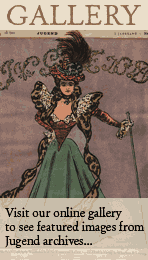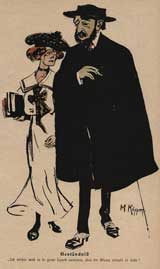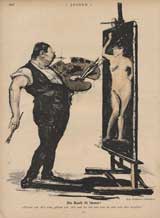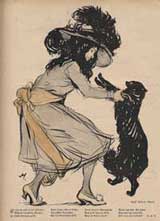Before Jugendstil: Art Nouveau and the Arts and Crafts Movement
Art Nouveau had started nearly two decades earlier in England, where it was called "Victory Style." It was based largely on the newly-popular English poet and printmaker William Blake, who had died more than a half-century earlier, and on the work of the Pre-Raphaelites; it also was influenced by Japanese print art's simplicity and elegance of line, and the Japanese habit of mixing words with images.
In Scotland, it was called "Edinborough Style," Spain called it "modernismo," Italy called it "Stile Liberty," and America simply called it the Arts and Crafts Movement. Art nouveau has the unique honour of having a different name in every country that adopted it. But since it took a different flavour in every country, perhaps that's only right. Art nouveau is a craft style, one that can be learned as a skill. It is easily recognized by its use of natural themes frozen in elegant linear curves. Stylized flowers and leaves are common, as are slender women bent in poses reminiscent of blooming flowers. Its ornamental style used exotic subjects or dreamlike poses, and blended them elegantly with the most basic and sensual symbols of humanity: death, resurrection, sex.
Millions of pages of advertising were decorated in this style, and it spread into other, practical art forms. Tiffany lamps, instantly recognizable today, were and are art nouveau pieces.
Critical to forms of art nouveau is a sense of design and balance. Practitioners of art nouveau were among the most gifted craftsmen of their time. Art nouveau started on paper and canvas, but quickly spread to architecture, carvings, furnishings, glassworks, ceramics - anything that could be artistic quickly gained an art nouveau following. And the new middle class bought these beautiful pieces, the art for the common man, hungrily.
In Germany, art nouveau was a little slow in catching on; they were still under the influence of the German Expressionists. But Jugend caught the tide rising under the Art Nouveau movement, and was the most popular art magazine sold in German-speaking countries from 1896 to 1914, the height of the German Jugendstil movement.
Jugendstil and other forms of this art aimed to erase any distinction between major and minor arts, unifying them all and centring them around human life. Because of this, the most homely objects, and the most utilitarian buildings, were treated in a new-art manner. Architecture was no longer just how a building was built, but its total art, each element of art in the building related to the whole. Jewellery was designed to enhance the woman's beauty, not to draw attention to the jewel as an ornament. And advertisements and placards used human figures in their print styles.
Despite its stylized form, Jugendstil was never a closed art. Instead, it maintained links to dozens of other art styles, ever ready to make a quick exit but open and accepting of other forms of art.






